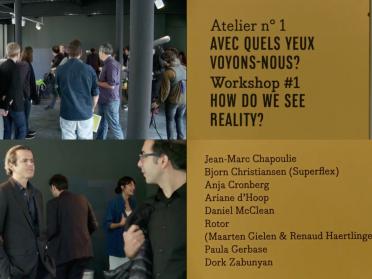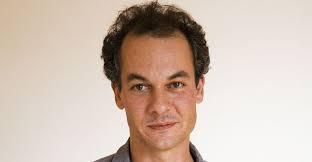
es Prolégomènes, Day 1 - Workshop n°1 "How do we see reality?", October 3rd 2013, Lafayette Anticipations, Paris
Led by Peter Szendy, with Anja Aronowsky Cronberg, Jean-Marc Chapoulie, Bjorn Christiansen (Superflex), Ariane d’Hoop, Daniel McClean, Rotor (Maarten Gielen & Renaud Haertlingen) Paula Gerbase and Dork Zabunyan.
« “How does one see things?” When asked that simple question, common sense would dictate the following answer: “With one’s own eyes”. To each his own outlook, to each his own viewpoint. Based on that premise, the ultimate dream, fantasy and ideal is to see reality through someone else’s eyes – to espouse or adopt their perspective, in a generous, empathetic effort to take part in a quite literal “exchange of views”.
But suppose we approached the question from a different angle. Suppose that, to start with, our own gaze was always haunted by, or interlaced with, that of other people. If that were true, the real challenge would not so much be for me to comprehend or appropriate a stranger’s point of view, but to bring to light this other perspective, inherent in mine, which influences the way I see reality and enables me to see it in the first place.
We may want to explore this hypothesis by referencing what Harun Farocki1 has called the “subjective phantom shot”, i.e. the person-centric equivalent of 1920’s cinema “phantom shots”. These shots, however, may not be unique to technical environments such as army camera crews or the video games designed by Farocki as part of his Serious Games, even though it is true that such devices, and related broadcasting technology, do have a deep influence on our visual perception.
But isn’t it possible that, even when using the naked eye, this “phantom view” is present or available to me? This is the question which this specific “Prolégomènes” workshop will try to examine in a number of ways – discursive, practical, demonstrative, playful, provocative, exploratory, aphoristic... One is reminded of a quote by Nietzsche, who wrote that “for the most part, the image is not made of impressions on the senses, but a product of the imagination” (Phantasie-Erzeugnis).
In fact, in this same posthumous fragment, dated autumn 1881, Nietzsche also remarked that “To hear well is continually to guess and to fill in”. Hence, the notion that human eyesight is endowed with Phantasie (often weakly rendered as “imagination”, forgetting that “fantasies” and “phantoms” too have fiction-creating powers) is analogous to the realization that there is a stranger’s ear, another ear, haunting ours: the phantom ear, from which we can hear. »
— Peter Szendy
1. « Le point de vue de la guerre », in Trafic, n° 50, 1991.
Les Prolégomènes / How do we see reality? Workshop #1
